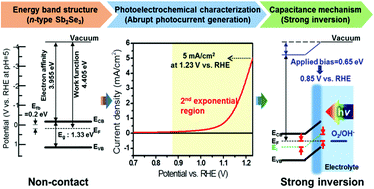当前位置:
X-MOL 学术
›
Energy Environ. Sci.
›
论文详情
Our official English website, www.x-mol.net, welcomes your feedback! (Note: you will need to create a separate account there.)
Electrochemical surface charge-inversion from semi-insulating Sb2Se3 photoanodes and abrupt photocurrent generation for water splitting†
Energy & Environmental Science ( IF 32.5 ) Pub Date : 2018-06-20 00:00:00 , DOI: 10.1039/c8ee00923f Young Been Kim 1, 2, 3, 4 , Joo Sung Kim 1, 2, 3, 4 , Seung Ki Baek 1, 2, 3, 4 , Young Dae Yun 1, 2, 3, 4 , Sung Woon Cho 1, 2, 3, 4 , Sung Hyeon Jung 1, 2, 3, 4 , Hyung Koun Cho 1, 2, 3, 4
Energy & Environmental Science ( IF 32.5 ) Pub Date : 2018-06-20 00:00:00 , DOI: 10.1039/c8ee00923f Young Been Kim 1, 2, 3, 4 , Joo Sung Kim 1, 2, 3, 4 , Seung Ki Baek 1, 2, 3, 4 , Young Dae Yun 1, 2, 3, 4 , Sung Woon Cho 1, 2, 3, 4 , Sung Hyeon Jung 1, 2, 3, 4 , Hyung Koun Cho 1, 2, 3, 4
Affiliation

|
Binary chalcogenide Sb2Se3 shows dominantly p-type electrical conductivity and poor photocathodic performance; however, its narrow band gap and low work function suggest satisfactory conditions for the generation of the inversion state at the surface if used as a photoanode. We propose a fabrication design for the synthesis of n-type Sb2Se3 by suppressing the formation of antisite SbSe defects, where excessively thick Se layers deposited on the electrodeposited Sb–Se precursors and high N2 pressure are introduced during the annealing step. Surprisingly, the linear sweep voltage (LSV) measurement from the n-type Sb2Se3 shows remarkably enhanced photocurrent density (up to approximately 5 mA cm−2 at 1.23 V vs. a reversible hydrogen electrode) under light illumination, which is the highest performance among pristine binary photoelectrodes yet recorded. In addition, the LSV curve exhibits non-typical behavior with a significant increase of the photocurrent at the specific potential. The measured current density under light illumination and no dark current indicate a vigorous photoactive reaction from photogenerated carriers. Here, the abrupt increase in photocurrent density is attributed to the conduction path of hole carriers originating from the charge inversion state with p-type conductivity at the surface, allowing significant carrier injection into the electrolyte. Based on electrochemical analyses, the mechanism that results in outstanding photocurrent gain from the novel n-type Sb2Se3 photoanodes was proposed and their further development possibilities via additional improvements were presented.
中文翻译:

半绝缘Sb 2 Se 3光电阳极产生的电化学表面电荷反转和水分解产生的突然光电流†
二元硫属元素化物Sb 2 Se 3表现出主要的p型导电性和较差的光致阴极性能。但是,其窄的带隙和低的功函暗示了如果用作光电阳极,则在表面上产生反转状态的令人满意的条件。我们提出了一种通过抑制反位Sb Se缺陷的形成来合成n型Sb 2 Se 3的制造设计,其中在退火步骤中引入了沉积在电沉积Sb-Se前体上的过厚Se层和高N 2压力。令人惊讶的是,根据n型Sb 2 Se 3进行的线性扫描电压(LSV)测量显示出显着增强的光电流密度(相对于1.23 V高达约5 mA cm -2(可逆氢电极)在光照射下,这是迄今为止记录的原始二元光电极中性能最高的。另外,LSV曲线表现出非典型行为,在特定电势下光电流显着增加。在光照和无暗电流下测得的电流密度表明来自光生载流子的剧烈光敏反应。在此,光电流密度的突然增加归因于空穴载流子的传导路径,该空穴载流子的传导路径源自表面处具有p型导电性的电荷反转状态,从而允许大量的载流子注入到电解质中。基于电化学分析,该机理可导致新型n型Sb 2 Se 3产生出色的光电流增益提出了光阳极,并提出了通过其他改进进一步发展的可能性。
更新日期:2018-06-20
中文翻译:

半绝缘Sb 2 Se 3光电阳极产生的电化学表面电荷反转和水分解产生的突然光电流†
二元硫属元素化物Sb 2 Se 3表现出主要的p型导电性和较差的光致阴极性能。但是,其窄的带隙和低的功函暗示了如果用作光电阳极,则在表面上产生反转状态的令人满意的条件。我们提出了一种通过抑制反位Sb Se缺陷的形成来合成n型Sb 2 Se 3的制造设计,其中在退火步骤中引入了沉积在电沉积Sb-Se前体上的过厚Se层和高N 2压力。令人惊讶的是,根据n型Sb 2 Se 3进行的线性扫描电压(LSV)测量显示出显着增强的光电流密度(相对于1.23 V高达约5 mA cm -2(可逆氢电极)在光照射下,这是迄今为止记录的原始二元光电极中性能最高的。另外,LSV曲线表现出非典型行为,在特定电势下光电流显着增加。在光照和无暗电流下测得的电流密度表明来自光生载流子的剧烈光敏反应。在此,光电流密度的突然增加归因于空穴载流子的传导路径,该空穴载流子的传导路径源自表面处具有p型导电性的电荷反转状态,从而允许大量的载流子注入到电解质中。基于电化学分析,该机理可导致新型n型Sb 2 Se 3产生出色的光电流增益提出了光阳极,并提出了通过其他改进进一步发展的可能性。


























 京公网安备 11010802027423号
京公网安备 11010802027423号